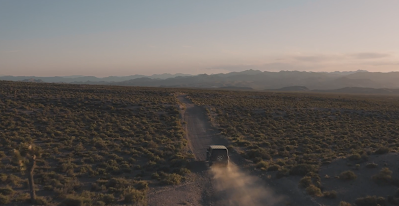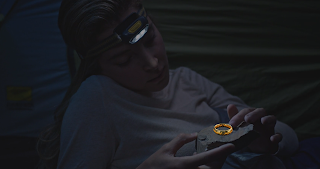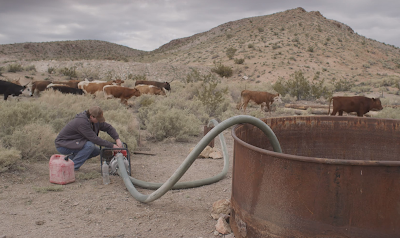Have you seen the movie Unconformity? It’s a great Indie film about a geology graduate student doing fieldwork in Nevada and finding herself along the way. We were asked to watch it recently and let us tell you, it’s accurate enough that watching it felt like a fever dream watching our own lives. She finds amazing fossils, she climbs, she gives herself food poisoning in the Nevada desert - and yes, both Amy & Meaghan have done all three and have been to the location where this was filmed. The film is out now on Amazon and Tubi in select countries and will be available worldwide on YouTube on November 15th.
Not only is the film a great and beautiful depiction of some of the realities of geology and paleontology, it also hits on some really important topics that plague Academia including sexism, career advancement, and power control issues. To this effect Unconformity also comes along with a guide on how to use the movie to facilitate conversations about these problems, which is available for any university or club to use. We were really excited about this aspect and the movie in general so we sat down with the director Jonathan DiMaio to discuss the movie and its impact a little further.
Meaghan: Where exactly was this filmed? We see some really amazing bouldering and climbing shots in particular that are especially beautiful.
Jonathan: All of the geology scenes were filmed near Beatty Nevada, about two hours northwest of Las Vegas, near the entrance to Death Valley. But the climbing we actually shot in Utah. The footage from the two locations was inter-spliced — we spent a lot of time trying to find a rock wall near Las Vegas where we could bring a film crew and equipment. There is plenty of rock climbing near Las Vegas but a lot of it was like… you have to hike in for an hour which is not really an option with a film crew, or the permits were impossible to get. In the end it all looks the same except to climbers who know Utah’s West Desert. When it’s cut together it works seamlessly.
Meaghan: So in this movie we see a really interesting contrast between how different people use public land, especially between geologists and landowners. When you started creating this movie, what made you choose that particular relationship to highlight?
Jonathan: I went out to the desert for the first time with geologists in 2013. I was a field camp manager for a friend of mine who is now a professor at Caltech, Claire Bucholz, but then she was leading a class of undergrads from MIT while completing her dissertation. I knew very little about the desert, geology, land rights issues, but I became interested because of my experience. Also, right after I left, Cliven Bundy and his family took over a highway in southern Nevada, so that sparked my interest in understanding the complexities of land use in the desert. While I was out there I ran across some characters in the desert—nothing like the Bundys who are of course violent right wing extremists—but I became interested in learning more about ranching culture. So I started doing research and getting in touch with ranchers.
Ranchers are pretty diverse in their beliefs, and the vast majority of them do not have these extreme Bundy-style anti-government beliefs even if many of them are on a different side of the political spectrum than I might be. But smaller ranches in Nevada and the West are struggling.
Over the last 30 years, ranching in southern Nevada has almost disappeared. That's for a number of reasons, including climate change, and I found I wanted to show how and why these ranches were disappearing. Some of it is related to economics - the ranchers in the movie may be blaming the government, but often larger corporations are buying up property. There’s also a historic drought, and it's difficult to run cattle on open range when there’s not much water. Land use is also limited when certain species are endangered, and yes, there are regulations to make sure land isn’t being abused. I also met a number of ranchers who had gotten to know geologists because they encountered each other out there on the range. So I thought it would be interesting to juxtapose the complexities of ranching and how a certain type of ranching is disappearing with the geology story. There seemed to be some potentially interesting interweaving themes and storylines.
Meaghan: Speaking of - were the cows paid actors?
Jonathan: Definitely not! They received payment in kind… in… um, whatever they eat, grass.
Meaghan: (laughing) Made a whole movie about ranching, still doesn’t know what cows eat!
Amy: (laughing like a hyena in the background because she obviously finds Meaghan hilarious and definitely isn't laughing because she knows Meaghan is obsessed with cows)
Jonathan: (laughs) Well when you work with animals on a film you expect that they will do anything and everything except for what you want them to do. So you need to plan for a lot of filming time for the cows to do their part, because they will do whatever they want.
Except there were no issues with the cows, which never never happens on a movie set with animals! They just did exactly what we wanted them to do - they even looked at the well! We had this mediocre fake well and they just looked at it like they were thirsty! And they were mooing and it was a great performance.
Meaghan: 10 out of 10 cow performance! Were these Hollywood cows, did you have to fly them out?
Jonathan: Hah, no. I knew we were going to have to find a rancher that would let us film on their property because we didn’t have the budget to hire a ranch for a week. I found this rancher, David Spicer, a very generous man, who let us film on his property. He’s also built bike paths for off road cycling all over his land, and folks from across the West come to his property to bike. On top of that he’s converted the springs on his property into ponds to make them mating grounds for a toad that’s at risk of being endangered. An interesting place.
He’s near Beatty, Nevada, and at the same time I’d been introduced to Emmy Smith at Johns Hopkins University who had found Ediacaran fossils in the same area. It was a great coincidence that it seemed like we should take advantage of!
Meaghan: oh yes - the Ediacaran fossils that are out there in Nevada are some of my favorites - you know what they are?
Jonathan: (becomes nervous this is a test and not a setup for a dumb joke)
Amy: (groans) No, Meaghan is - she’s setting you up for a punchline -
Meaghan: (with the enthusiasm of a toddler) They’re penis worms!!! Treptichnus, a trace fossil made up by penis worms, the first ecosystem engineers -
Jonathan: Were they the first hardbodied organisms?
Meaghan: No they - OH! Yes. Oh no I got so excited about penis worms I almost missed your excellent hard body joke. Anyhow… lots of penis worms, very funny.
Jonathan: We actually chose to use fossils like Dickinsonia and Spriggina that haven’t been found in the Southwest because we wanted the discovery in the movie to feel like a significant finding. So we intentionally put fossils out there that have not been found there!
Amy: That makes sense! An absence of evidence does not mean evidence of absence too, they could still be out there and we just haven’t found ‘em.Amy: This might be some of the most realistic depictions of academia we’ve seen in a movie before - you really nailed both the infighting and the reasons for it, not to give too much away. What made you decide to make a film about this, and how did you do it so well?
Jonathan: The viewpoint into that world . . . Well I am the son of scientists. My dad is a virologist and my mom is a geneticist. So I grew up in an environment where I got to see behind that curtain, see that academia can at times be petty. There’s gossip, there’s competition, and whenever you get into an ecosystem like this, especially one where something like tenure is being dangled in front of people, folks can behave poorly. So I knew about that world and it was relatively easy to show.
As far as the relationship between Alex and her advisor… I had a mentor, a pretty well-known filmmaker, that took advantage of me in a similar way a number of years ago. I didn’t really want to make a movie about that because it's not that interesting and -
Amy: It’s too close.
Jonathan: Yeah, it’s too close. And I have plenty of friends who are in academia who have terrible stories. I had a friend who was applying for a position and somehow someone also applying for the position gained access to the submission process and actually changed her résumé. In college I saw a very-well respected academic tell a student that his idea was too “outside the box” for an essay in a class, but that he liked the idea so much he was going to use it in his next book. People will always fight for credit and prestige, no matter the field. It’s not limited to science or academia—it certainly happens in film all the time—but I wanted to show that side of academia.
Meaghan: This film touches on some really pervasive problems in academia and field research, without making them the center of the movie which we really appreciate. And to that end, there is a diversity and equity initiative that actually goes along with the film. Can you tell us a little bit more about this initiative - how it started, how people can get involved, what the goal is?
Jonathan: I showed an early cut of the film to a number of geologists and other academics for feedback, and I was put in touch with Chris Spencer, a professor at Queen's University in Kingston, Canada, because I was looking for help to film the thin sections that are part of the title sequence. Chris runs Traveling Geologist and is very interested in geology outreach and making the geosciences more inclusive (he’s also, it turns out, pretty good with a camera too!). Those early viewers along with Chris saw potential in using the film to discuss issues in the geosciences that are depicted in the movie — sexism, plagiarism, bullying, questions related to diversity.
Someone suggested that we make a guide to accompany the film, I mentioned that to Chris, and it kind of took off from there. The idea is that you watch the film as a group, then have a facilitated conversation about the movie and how its portrayal of academia relates to your school or organization. To be clear, the guide we created is not something that Chris and I wrote - we had a whole bunch of people who are really committed to DEI in the geosciences advising on the project, and we had DEI consultants help craft the guide following best practices for what are important and often delicate conversations. Also, something that’s really important to me is that conversations and dialogues about DEI are accompanied by action and funding. To that end, Traveling Geologist has created a scholarship fund, and half of the proceeds from the screenings will go to funding this scholarship, which will support students from underrepresented groups in the geosciences—people who are BIPOC, women, or from low income backgrounds.
We’ve decided to make the DEI guide available to anyone who asks for it, and after toying with some pricing models, we’ve decided to go with a “Pay what you want” model for schools and organizations. As I mentioned, half the money goes directly to the scholarship. The other half goes to the producers who invested to make the film, and then once they recoup their investment, all further money raised from these screenings will go 100% to the scholarship.
Amy: How do people access this guide?
Jonathan: Email info@geologymovie.com to get a copy!
Meaghan: That sounds like a great initiative! Thank you so much for speaking with us. We really enjoyed the movie and it was great to talk more about it with you.
Jonathan: Thank you for having me.
-
Ultimately, we loved this film, loved the geology, and we think you will too. If you're interested in having your University host a movie showing with the DEI guide afterwards, email info@geologymovie.com. You can check the movie out on Amazon and Tubi now. You should also go and rate it - the more ratings it gets the more attention it gets, and that means we'll get to see more movies like this in the future.




No comments:
Post a Comment